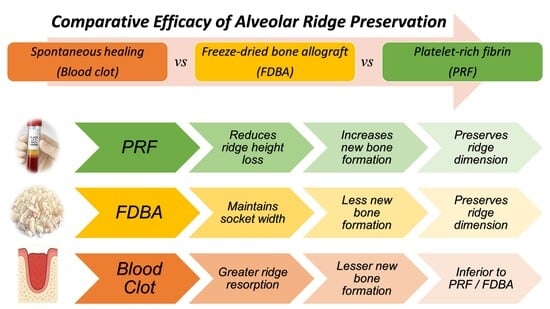Comparative Efficacy of Platelet-Rich Fibrin, Freeze-Dried Bone Allograft, or Spontaneous Healing for Alveolar Ridge Preservation: Systematic Review and Meta-Analysis
Abstract
1. Introduction
2. Materials and Methods
2.1. Review Protocol
2.2. Research Question
2.3. Inclusion and Exclusion Criteria
2.4. Study Selection Process and Data Extraction
2.5. Data Synthesis and Statistical Analysis
3. Results
3.1. Study Selection
3.2. Risk-of-Bias and Quality Assessment of the Included Studies
3.3. Meta-Analysis—Reduction in Alveolar Ridge Height
3.4. Meta-Analysis—Reduction in Alveolar Ridge Width
3.5. Meta-Analysis—Gain in Histometric Bone Area (%) in the Regenerated Bone
3.6. Meta-Analysis—Gain in Radiographic Bone Fill (%) in the Regenerated Bone
3.7. Reduction in Soft-Tissue Socket Width
3.8. Sensitivity Analysis
3.9. Summary of Findings and Certainty of Evidence
3.10. Differences in PRF Preparation Protocols Among Included Studies
4. Discussion
4.1. Outcomes-Based Summary and Inference
4.2. Clinical Significance
4.3. Certainty of Reported Evidence
4.4. Study Limitations
4.5. Future Directions
5. Conclusions
Supplementary Materials
Author Contributions
Funding
Institutional Review Board Statement
Informed Consent Statement
Data Availability Statement
Conflicts of Interest
Abbreviations
| ARP | Alveolar ridge preservation |
| PRF | Platelet-rich fibrin |
| FDBA | Freeze-dried bone allograft |
| SMD | Standardized mean deviation |
| CI | Confidence interval |
| SD | Standard deviation |
| PICOS | Population, Intervention, Comparator, Outcomes, Study design |
| PRISMA | Preferred reporting items for systematic reviews and meta-analysis |
| RCT | Randomized controlled trial |
| CCT | Controlled clinical trial |
| RoB | Risk-of-bias |
| ROBINS | Risk-of-bias for non-randomized studies of interventions |
| ROBVIS | Risk-of-bias visualization |
| GRADE | Grading of Recommendations, Assessment, Development and Evaluations |
| SoF | Summary of findings |
| CBCT | Cone beam computed tomography |
| ACD | Acidulated citrate dextrose |
| RPM | Rotations per minute |
| RBC | Red blood cell |
| WBC | White blood cell |
| PRGF | Plasma rich in growth factors |
| PPP | Platelet poor plasma |
References
- De Risi, V.; Clementini, M.; Vittorini, G.; Mannocci, A.; De Sanctis, M. Alveolar ridge preservation techniques: A systematic review and meta-analysis of histological and histomorphometrical data. Clin. Oral Implant. Res. 2015, 26, 50–68. [Google Scholar] [CrossRef]
- Al-Maawi, S.; Becker, K.; Schwarz, F.; Sader, R.; Ghanaati, S. Efficacy of platelet-rich fibrin in promoting the healing of extraction sockets: A systematic review. Int. J. Implant Dent. 2021, 7, 117. [Google Scholar] [CrossRef]
- Alrayyes, Y.; Aloraini, S.; Alkhalaf, A.; Aljasser, R. Soft-Tissue Healing Assessment after Extraction and Socket Preservation Using Platelet-Rich Fibrin (PRF) in Smokers: A Single-Blinded, Randomized, Controlled Clinical Trial. Diagnostics 2022, 12, 2403. [Google Scholar] [CrossRef]
- Morjaria, K.R.; Wilson, R.; Palmer, R.M. Bone healing after tooth extraction with or without an intervention: A systematic review of randomized controlled trials. Clin. Implant. Dent. Relat. Res. 2014, 16, 1–20. [Google Scholar] [CrossRef] [PubMed]
- Egierska, D.; Perszke, M.; Mazur, M.; Duś-Ilnicka, I. Platelet-rich plasma and platelet-rich fibrin in oral surgery: A narrative review. Dent. Med. Probl. 2023, 60, 177–186. [Google Scholar] [CrossRef] [PubMed]
- Bianchini, M.A.; Buttendorf, A.R.; Benfatti, C.A.; Bez, L.V.; Ferreira, C.F.; de Andrade, R.F. The use of freeze-dried bone allograft as an alternative to autogenous bone graft in the atrophic maxilla: A 3-year clinical follow-up. Int. J. Periodontics Restor. Dent. 2009, 29, 643–647. [Google Scholar]
- Alrayyes, Y.; Al-Jasser, R. Regenerative Potential of Platelet Rich Fibrin (PRF) in Socket Preservation in Comparison with Conventional Treatment Modalities: A Systematic Review and Meta-Analysis. Tissue Eng. Regen. Med. 2022, 19, 463–475. [Google Scholar] [CrossRef]
- Alhaj, F.; Shokry, M.; Attia, N. The efficiency of using advanced platelet rich fibrin–Autogenous bone graft mixture around immediately placed dental implants in mandibular molar region: (Randomized controlled clinical trial). Egypt. Dent. J. 2018, 64, 2023–2035. [Google Scholar] [CrossRef]
- Azangookhiavi, H.; Habibzadeh, S.; Zahmatkesh, H.; Mellati, E.; Mosaddad, S.A.; Dadpour, Y. The effect of platelet-rich fibrin (PRF) versus freeze-dried bone allograft (FDBA) used in alveolar ridge preservation on the peri-implant soft and hard tissues: A randomized clinical trial. BMC Oral Health 2024, 24, 693. [Google Scholar] [CrossRef]
- Azangookhiavi, H.; Ghodsi, S.; Jalil, F.; Dadpour, Y. Comparison of the Efficacy of Platelet-Rich Fibrin and Bone Allograft for Alveolar Ridge Preservation after Tooth Extraction: A Clinical Trial. Front. Dent. 2020, 17, 1–6. [Google Scholar] [CrossRef]
- Dragonas, P.; Katsaros, T.; Avila-Ortiz, G.; Chambrone, L.; Schiavo, J.H.; Palaiologou, A. Effects of leukocyte-platelet-rich fibrin (L-PRF) in different intraoral bone grafting procedures: A systematic review. Int. J. Oral Maxillofac. Surg. 2019, 48, 250–262. [Google Scholar] [CrossRef]
- Horváth, A.; Mardas, N.; Mezzomo, L.A.; Needleman, I.G.; Donos, N. Alveolar ridge preservation. A systematic review. Clin. Oral Investig. 2013, 17, 341–363. [Google Scholar] [CrossRef]
- Miron, R.J.; Fujioka-Kobayashi, M.; Bishara, M.; Zhang, Y.; Hernandez, M.; Choukroun, J. Platelet-Rich Fibrin and Soft Tissue Wound Healing: A Systematic Review. Tissue Eng. Part B Rev. 2017, 23, 83–99. [Google Scholar] [CrossRef]
- Miron, R.J.; Fujioka-Kobayashi, M.; Moraschini, V.; Zhang, Y.; Gruber, R.; Wang, H.L. Efficacy of platelet-rich fibrin on bone formation, part 1: Alveolar ridge preservation. Int. J. Oral Implantol. 2021, 14, 181–194. [Google Scholar]
- Alavi, S.A.; Imanian, M.; Alkaabi, S.; Al-Sabri, G.; Forouzanfar, T.; Helder, M. A systematic review and meta-analysis on the use of regenerative graft materials for socket preservation in randomized clinical trials. Oral Surg. Oral Med. Oral Pathol. Oral Radiol. 2024, 138, 702–718. [Google Scholar] [CrossRef]
- Atieh, M.A.; Alfardan, L.; Alsabeeha, N.H.M. Flapped versus flapless alveolar ridge preservation: A systematic review and meta-analysis. Int. J. Oral Maxillofac. Surg. 2022, 51, 133–142. [Google Scholar] [CrossRef]
- Canellas, J.; Soares, B.N.; Ritto, F.G.; Vettore, M.V.; Vidigal Júnior, G.M.; Fischer, R.G.; Medeiros, P.J.D. What grafting materials produce greater alveolar ridge preservation after tooth extraction? A systematic review and network meta-analysis. J. Cranio-Maxillo-Facial Surg. 2021, 49, 1064–1071. [Google Scholar] [CrossRef]
- Canellas, J.V.d.S.; Ritto, F.G.; Figueredo, C.M.d.S.; Fischer, R.G.; de Oliveira, G.P.; Thole, A.A.; Medeiros, P.J.D. Histomorphometric evaluation of different grafting materials used for alveolar ridge preservation: A systematic review and network meta-analysis. Int. J. Oral Maxillofac. Surg. 2020, 49, 797–810. [Google Scholar] [CrossRef] [PubMed]
- Liu, M.; Liu, Y.; Luo, F. The role and mechanism of platelet-rich fibrin in alveolar bone regeneration. Biomed. Pharmacother. 2023, 168, 115795. [Google Scholar] [CrossRef] [PubMed]
- Page, M.J.; McKenzie, J.E.; Bossuyt, P.M.; Boutron, I.; Hoffmann, T.C.; Mulrow, C.D.; Shamseer, L.; Tetzlaff, J.M.; Akl, E.A.; Brennan, S.E.; et al. The PRISMA 2020 statement: An updated guideline for reporting systematic reviews. BMJ (Clin. Res. Ed.) 2021, 372, n71. [Google Scholar] [CrossRef]
- Sterne, J.A.; Hernán, M.A.; Reeves, B.C.; Savović, J.; Berkman, N.D.; Viswanathan, M.; Henry, D.; Altman, D.G.; Ansari, M.T.; Boutron, I.; et al. ROBINS-I: A tool for assessing risk of bias in non-randomised studies of interventions. BMJ (Clin. Res. Ed.) 2016, 355, i4919. [Google Scholar] [CrossRef]
- Sterne, J.A.C.; Savović, J.; Page, M.J.; Elbers, R.G.; Blencowe, N.S.; Boutron, I.; Cates, C.J.; Cheng, H.Y.; Corbett, M.S.; Eldridge, S.M.; et al. RoB 2: A revised tool for assessing risk of bias in randomised trials. BMJ (Clin. Res. Ed.) 2019, 366, l4898. [Google Scholar] [CrossRef]
- McGuinness, L.A.; Higgins, J.P.T. Risk-of-bias VISualization (robvis): An R package and Shiny web app for visualizing risk-of-bias assessments. Res. Synth. Methods 2021, 12, 55–61. [Google Scholar] [CrossRef]
- Guyatt, G.H.; Oxman, A.D.; Vist, G.E.; Kunz, R.; Falck-Ytter, Y.; Alonso-Coello, P.; Schünemann, H.J. GRADE: An emerging consensus on rating quality of evidence and strength of recommendations. BMJ (Clin. Res. Ed.) 2008, 336, 924–926. [Google Scholar] [CrossRef] [PubMed]
- Aldommari, E.A.; Omair, A.; Qasem, T. Titanium-prepared platelet-rich fibrin enhances alveolar ridge preservation: A randomized controlled clinical and radiographic study. Sci. Rep. 2025, 15, 24065. [Google Scholar] [CrossRef] [PubMed]
- Karagah, A.; Tabrizi, R.; Mohammadhosseinzade, P.; Mirzadeh, M.; Tofangchiha, M.; Lajolo, C.; Patini, R. Effect of Sinus Floor Augmentation with Platelet-Rich Fibrin Versus Allogeneic Bone Graft on Stability of One-Stage Dental Implants: A Split-Mouth Randomized Clinical Trial. Int. J. Environ. Res. Public Health 2022, 19, 9569. [Google Scholar] [CrossRef] [PubMed]
- Tajima, N.; Ohba, S.; Sawase, T.; Asahina, I. Evaluation of sinus floor augmentation with simultaneous implant placement using platelet-rich fibrin as sole grafting material. Int. J. Oral Maxillofac. Implant. 2013, 28, 77–83. [Google Scholar] [CrossRef]
- Girish Rao, S.; Bhat, P.; Nagesh, K.S.; Rao, G.H.; Mirle, B.; Kharbhari, L.; Gangaprasad, B. Bone regeneration in extraction sockets with autologous platelet rich fibrin gel. J. Maxillofac. Oral Surg. 2013, 12, 11–16. [Google Scholar] [CrossRef]
- Thakkar, D.J.; Deshpande, N.C.; Dave, D.H.; Narayankar, S.D. A comparative evaluation of extraction socket preservation with demineralized freeze-dried bone allograft alone and along with platelet-rich fibrin: A clinical and radiographic study. Contemp. Clin. Dent. 2016, 7, 371–376. [Google Scholar] [CrossRef]
- Alzahrani, A.A.; Murriky, A.; Shafik, S. Influence of platelet rich fibrin on post-extraction socket healing: A clinical and radiographic study. Saudi Dent. J. 2017, 29, 149–155. [Google Scholar] [CrossRef]
- Clark, D.; Rajendran, Y.; Paydar, S.; Ho, S.; Cox, D.; Ryder, M.; Dollard, J.; Kao, R.T. Advanced platelet-rich fibrin and freeze-dried bone allograft for ridge preservation: A randomized controlled clinical trial. J. Periodontol. 2018, 89, 379–387. [Google Scholar] [CrossRef] [PubMed]
- Zhang, Y.; Ruan, Z.; Shen, M.; Tan, L.; Huang, W.; Wang, L.; Huang, Y. Clinical effect of platelet-rich fibrin on the preservation of the alveolar ridge following tooth extraction. Exp. Ther. Med. 2018, 15, 2277–2286. [Google Scholar] [CrossRef]
- Taha, M. Short term dimensional bony changes following teeth extraction in the esthetic zone and the use of PRF as a sole grafting material: Randomized controlled trial. Egypt. J. Oral Maxillofac. Surg. 2019, 10, 47–57. [Google Scholar] [CrossRef]
- Stumbras, A.; Januzis, G.; Gervickas, A.; Kubilius, R.; Juodzbalys, G. Randomized and Controlled Clinical Trial of Bone Healing After Alveolar Ridge Preservation Using Xenografts and Allografts Versus Plasma Rich in Growth Factors. J. Oral Implantol. 2020, 46, 515–525. [Google Scholar] [CrossRef] [PubMed]
- Ivanova, V.; Chenchev, I.; Zlatev, S.; Mijiritsky, E. Comparison Study of the Histomorphometric Results after Socket Preservation with PRF and Allograft Used for Socket Preservation-Randomized Controlled Trials. Int. J. Environ. Res. Public Health 2021, 18, 7451. [Google Scholar] [CrossRef]
- Stumbras, A.; Galindo-Moreno, P.; Januzis, G.; Juodzbalys, G. Three-dimensional analysis of dimensional changes after alveolar ridge preservation with bone substitutes or plasma rich in growth factors: Randomized and controlled clinical trial. Clin. Implant Dent. Relat. Res. 2021, 23, 96–106. [Google Scholar] [CrossRef] [PubMed]
- Aravena, P.C.; Sandoval, S.P.; Pizarro, F.E.; Simpson, M.I.; Castro-Adams, N.; Serandour, G.; Rosas, C. Leukocyte and Platelet-Rich Fibrin Have Same Effect as Blood Clot in the 3-Dimensional Alveolar Ridge Preservation. A Split-Mouth Randomized Clinical Trial. J. Oral Maxillofac. Surg. 2021, 79, 575–584. [Google Scholar] [CrossRef]
- Niedzielska, I.; Ciapiński, D.; Bąk, M.; Niedzielski, D. The Assessment of the Usefulness of Platelet-Rich Fibrin in the Healing Process Bone Resorption. Coatings 2022, 12, 247. [Google Scholar] [CrossRef]
- Nagrani, T.; Kumar, S.; Haq, M.A.; Dhanasekaran, S.; Gajjar, S.; Patel, C.; Sinha, S.; Haque, M. Use of Injectable Platelet-Rich Fibrin Accompanied by Bone Graft in Socket Endurance: A Radiographic and Histological Study. Cureus 2023, 15, e46909. [Google Scholar] [CrossRef]
- Khaddour, A.S.; Ghiță, R.E.; Ionescu, M.; Rîcă, R.G.; Mercuț, V.; Manolea, H.O.; Camen, A.; Drăghici, E.C.; Radu, A.; Popescu, S.M. Healing of Extraction Sites after Alveolar Ridge Preservation Using Advanced Platelet-Rich Fibrin: A Retrospective Study. Bioengineering 2024, 11, 566. [Google Scholar] [CrossRef]
- Molina-Barahona, M.; Castillo, J.; Freire-Meza, E.; Vásquez-Palacios, A.C.; Morales-Navarro, D.; Avecillas-Rodas, R. Radiographic Evaluation in Alveolar Preservation Using Platelet-Rich Fibrin: A Randomized Controlled Trial. Dent. J. 2025, 13, 231. [Google Scholar] [CrossRef]
- Khan, J.; Bandi, S.; Gangineni, S.; Kummari, S.; Pradeep, D.G.; Hinduja, T. Evaluation of Alveolar Ridge Dimensions by Socket Preservation Therapy Using a Bone Graft and Platelet-Rich Fibrin: A Randomized Controlled Trial. Cureus 2024, 16, e60388. [Google Scholar] [CrossRef]
- Wardani, A.; Tran, B.; Duterre, M.; Larabi, I.; Waskiewicz, K.; Louryan, S.; Evrard, L. Healing of particulate allografts mixed with platelet concentrates in ridge preservation and sinus lift: A prospective histomorphometric study. Morphologie 2023, 107, 100596. [Google Scholar] [CrossRef] [PubMed]
- Arumugam, P.; Baburaj, M.D.; Yadalam, P.K.; Ardila, C.M. A comparative study of platelet-rich fibrin plugs versus biphasic calcium phosphate in treating infrabony defects in patients with periodontitis: Insights from a randomized controlled trial. J. Clin. Exp. Dent. 2025, 17, e560–e568. [Google Scholar] [CrossRef]
- Borg, T.D.; Mealey, B.L. Histologic healing following tooth extraction with ridge preservation using mineralized versus combined mineralized-demineralized freeze-dried bone allograft: A randomized controlled clinical trial. J. Periodontol. 2015, 86, 348–355. [Google Scholar] [CrossRef]
- Pan, J.; Xu, Q.; Hou, J.; Wu, Y.; Liu, Y.; Li, R.; Pan, Y.; Zhang, D. Effect of platelet-rich fibrin on alveolar ridge preservation: A systematic review. J. Am. Dent. Assoc. 2019, 150, 766–778. [Google Scholar] [CrossRef]
- Garg, M.; Srivastava, V.; Chauhan, R.; Pramanik, S.; Khanna, R. Application of platelet-rich fibrin and freeze-dried bone allograft following apicoectomy: A comparative assessment of radiographic healing. Indian J. Dent. Res. 2023, 34, 40–44. [Google Scholar] [CrossRef]
- Madi, M.; Almindil, I.; Alrassasi, M.; Alramadan, D.; Zakaria, O.; Alagl, A.S. Cone-Beam Computed Tomography and Histological Findings for Socket Preservation Techniques Using Different Grafting Materials: A Systematic Review. J. Funct. Biomater. 2023, 14, 282. [Google Scholar] [CrossRef] [PubMed]
- Philip, M.R.; AlOtaibi, S.; AlEid, B. The success rates of various surgical techniques for socket preservation in the aesthetic zone: A systematic review and meta-analysis. J. Oral Maxillofac. Surg. Med. Pathol. 2022, 34, 91–107. [Google Scholar] [CrossRef]
- Razi, M.A.; Mahajan, A.; Zarrin, R.; Roy, S.; Singh, M.K.; Kumari, S. Impact of Platelet-Rich Fibrin (PRF) Versus Freeze-Dried Bone Allograft (FDBA) on Peri-Implant Soft and Hard Tissue in Alveolar Ridge Preservation. J. Pharm. Bioallied Sci. 2024, 16, S3550–S3552. [Google Scholar] [CrossRef] [PubMed]
- Dhamija, R.; Shetty, V.; Vineeth, K.; Nagaraju, R.; Rao, R.S. Socket preservation with demineralized freeze-dried bone allograft and platelet-rich fibrin for implant site development: A randomized controlled trial. J. Indian Prosthodont. Soc. 2020, 20, 304–311. [Google Scholar] [CrossRef]
- Beldhi, M.; Penmetsa, G.S.; Gottumukkala, S.; Ramesh, K.S.V.; Kumar, P.M.; Manchala, B. Evaluation and comparison of autologous particulate dentin with demineralized freeze dried bone allograft in ridge preservation procedures—A prospective clinical study. Clin. Oral Investig. 2024, 28, 492. [Google Scholar] [CrossRef]
- Liu, Y.; Li, X.; Jiang, C.; Guo, H.; Luo, G.; Huang, Y.; Yuan, C. Clinical applications of concentrated growth factors membrane for sealing the socket in alveolar ridge preservation: A randomized controlled trial. Int. J. Implant Dent. 2022, 8, 46. [Google Scholar] [CrossRef]
- Elboraey, M.O.; Alqutaibi, A.Y.; Aboalrejal, A.N.; Borzangy, S.; Zafar, M.S.; Al-Gabri, R.; Alghauli, M.A.; Ramalingam, S. Regenerative approaches in alveolar bone augmentation for dental implant placement: Techniques, biomaterials, and clinical decision-making: A comprehensive review. J. Dent. 2025, 154, 105612. [Google Scholar] [CrossRef] [PubMed]
- Baniasadi, B.; Evrard, L. Alveolar Ridge Preservation After Tooth Extraction with DFDBA and Platelet Concentrates: A Radiographic Retrospective Study. Open Dent. J. 2017, 11, 99–108. [Google Scholar] [CrossRef] [PubMed]
- Al-Badran, A.; Bierbaum, S.; Wolf-Brandstetter, C. Does the Choice of Preparation Protocol for Platelet-Rich Fibrin Have Consequences for Healing and Alveolar Ridge Preservation After Tooth Extraction? A Meta-Analysis. J. Oral Maxillofac. Surg. 2023, 81, 602–621. [Google Scholar] [CrossRef] [PubMed]
- Elsheikh, H.A.-E.; Abdelsameaa, S.E.; Elbahnasi, A.A.; Abdel-Rahman, F.H. Comparison between platelet rich fibrin as space filling material versus xenograft and alloplastic bone grafting materials in immediate implant placement: A randomized clinical trial. BMC Oral Health 2023, 23, 977. [Google Scholar] [CrossRef]
- Agarwal, A.; Gupta, N.D.; Jain, A. Platelet rich fibrin combined with decalcified freeze-dried bone allograft for the treatment of human intrabony periodontal defects: A randomized split mouth clinical trail. Acta Odontol. Scand. 2016, 74, 36–43. [Google Scholar] [CrossRef]
- Sherif, M.A.; Anter, E.; Graetz, C.; El-Sayed, K.F. Injectable platelet-rich fibrin with vitamin C as an adjunct to non-surgical periodontal therapy in the treatment of stage-II periodontitis: A randomized controlled clinical trial. BMC Oral Health 2025, 25, 772. [Google Scholar] [CrossRef]



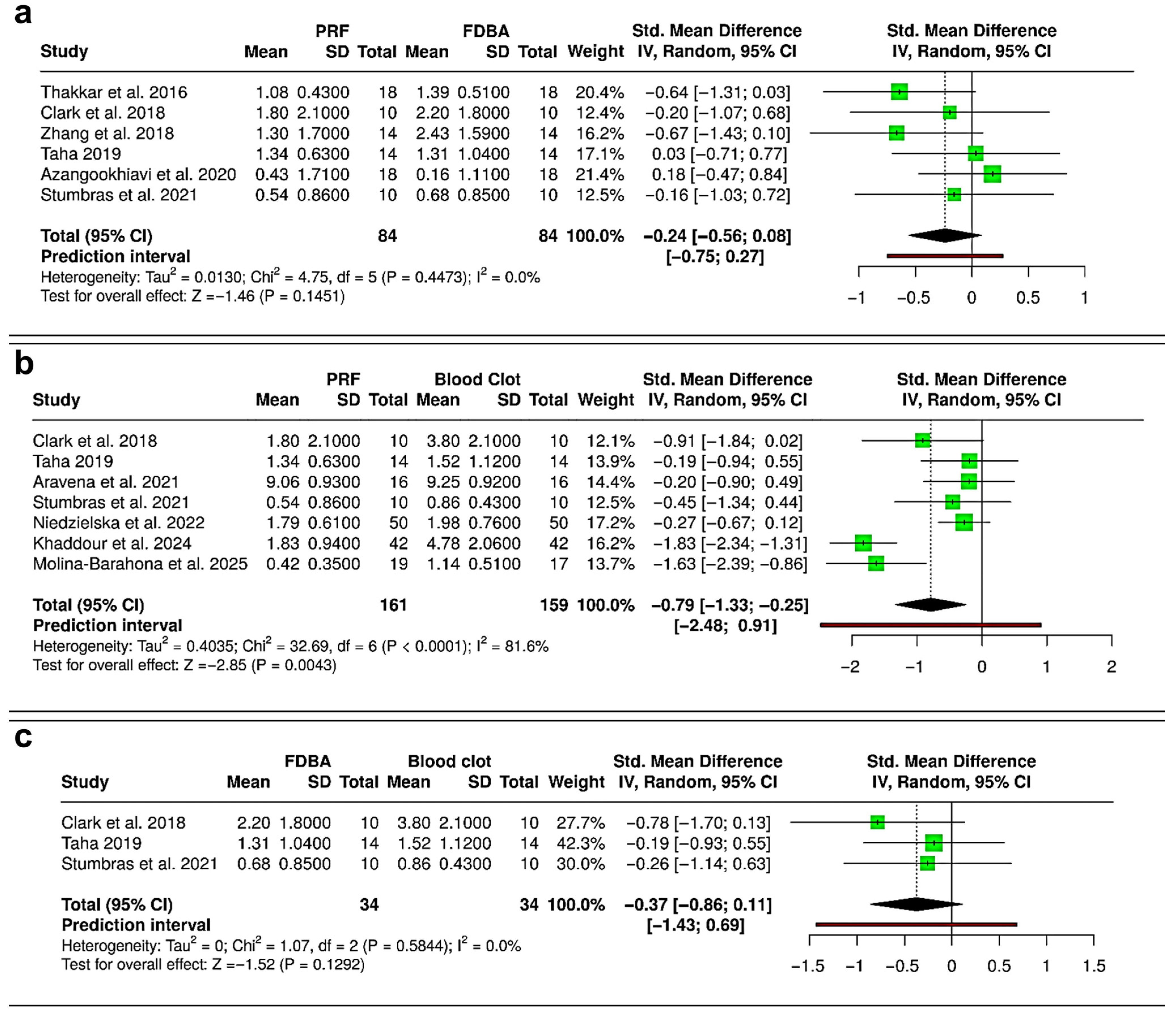
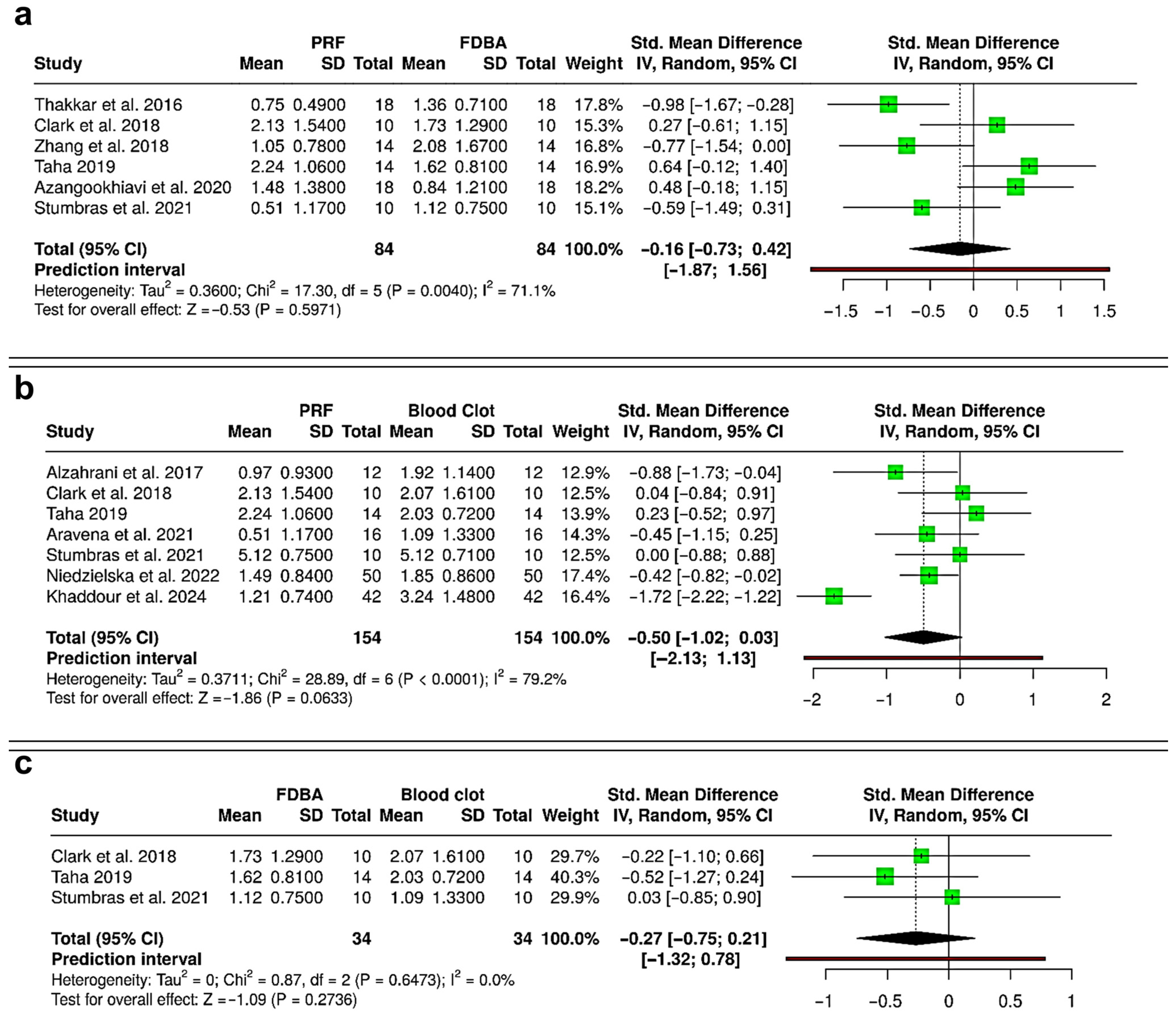
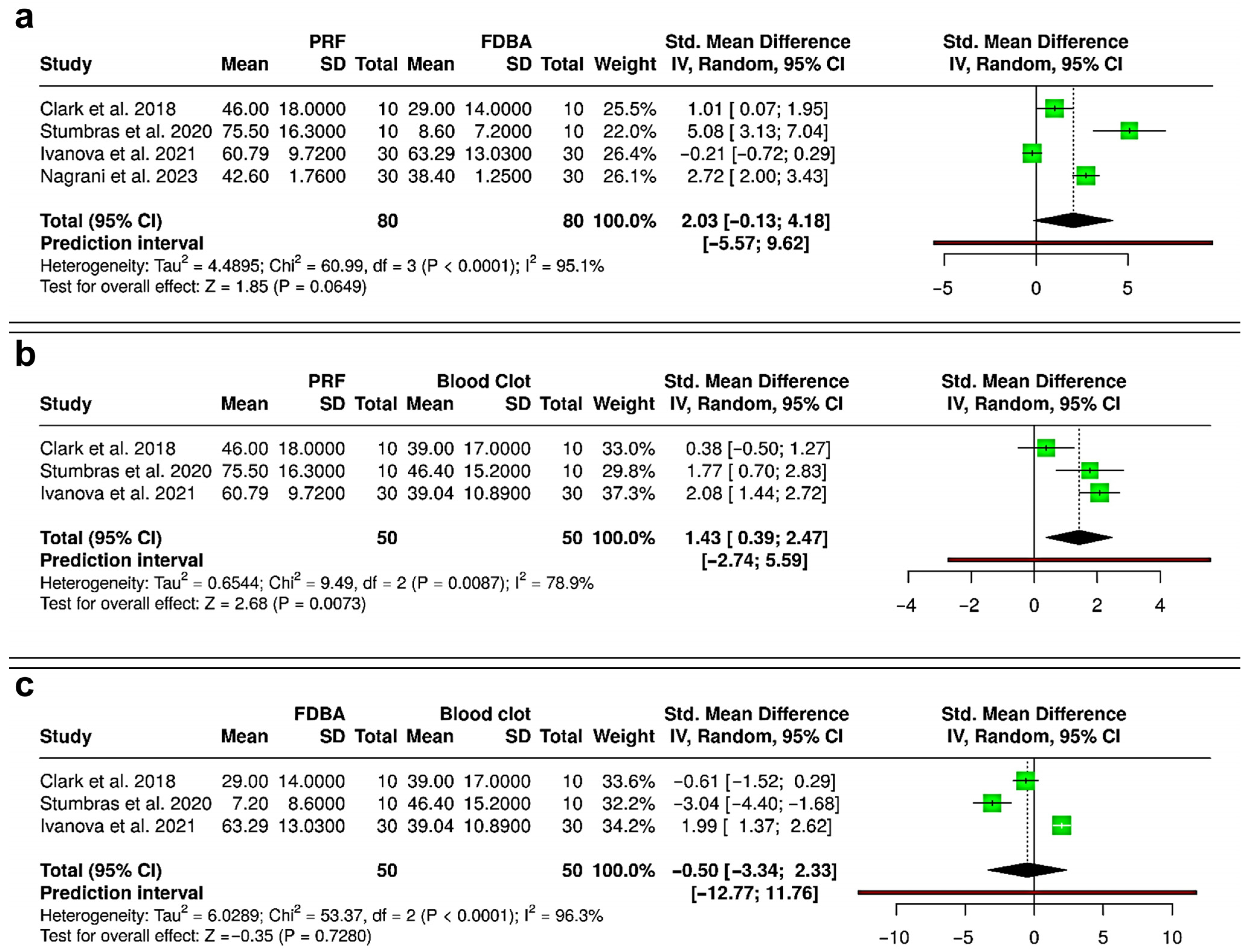

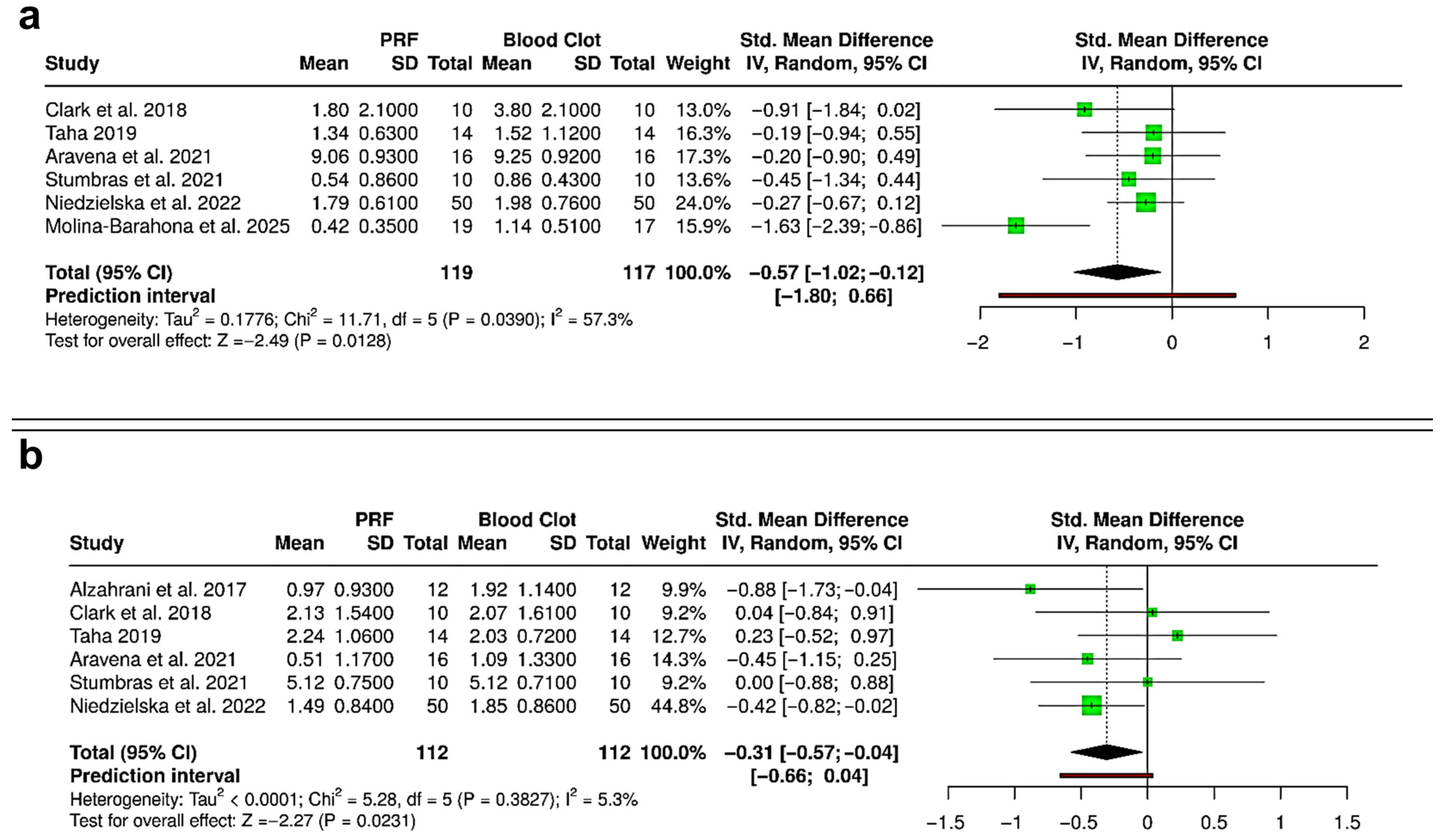
| PICOS Criterion | Description |
|---|---|
| Population (P) | Human patients undergoing tooth extraction and subsequent alveolar ridge/socket preservation prior to implant placement |
| Intervention (I) | Socket preservation with platelet-rich fibrin (PRF) |
| Comparator (C) | Socket preservation with freeze-dried bone allograft (FDBA) and/or spontaneous healing with blood clot only |
| Outcomes (O) | Primary quantitative outcome measures: Dimensional change in alveolar bone height and width Secondary outcome measures: Quantitative histological and radiological evaluation for bone formation, reduction in soft-tissue socket width, post-implant stability, marginal bone loss, and patient-centered outcomes |
| Study design (S) | Randomized controlled trials (RCTs), comparative cohort studies and controlled clinical trials (CCTs) |
| Author (Year) | Study Design | Study Objective | Intervention vs. Comparator | Sample Size Per Group (Sockets) | Follow-Up Period (in Months) | Key Outcome |
|---|---|---|---|---|---|---|
| Tajima et al. (2013) [27] * | Prospective Interventional study | Assessed socket grafting and sinus floor augmentation along with simultaneous implant placement using PRF as the sole grafting material. | PRF vs. none | 17 | 6 | Sinus elevation with PRF supported natural bone regeneration during simultaneous implant placement. |
| Girish Rao et al. (2013) [28] | RCT | Examined the effect of autologous PRF on bone regeneration after tooth extraction. | PRF vs. spontaneous healing | 22 | 6 | PRF enhanced postoperative bone regeneration and density, supporting its role in hard tissue healing. |
| Thakkar et al. (2016) [29] | RCT | Evaluated bone fill in extraction sockets using FDBA alone and PRF, based on clinical and radiographic outcomes. | PRF vs. FDBA | 18 | 6 | PRF achieved comparable socket preservation outcomes to FDBA and may serve as an adjunctive material. |
| Alzahrani et al. (2017) [30] | RCT | Assessed socket healing clinically and radiographically when treated with autologous PRF. | PRF vs. spontaneous healing | 12 | 3 | PRF yielded greater ridge width maintenance and radiographic bone fill than spontaneous healing. |
| Clark et al. (2018) [31] | RCT | Compared PRF and FDBA for their effectiveness in vital bone formation and maintenance of alveolar ridge dimensions. | PRF vs. FDBA vs. spontaneous healing | 10 | 4 | Both PRF alone and PRF with FDBA were effective for alveolar ridge preservation. |
| Zhang et al. (2018) [32] | RCT | Examined the clinical efficacy of PRF in preserving alveolar ridge architecture after tooth extraction. | PRF vs. FDBA | 14 | 3 | PRF enhanced bone quality and accelerated bone formation, though it did not significantly reduce socket resorption. |
| Taha (2019) [33] | RCT | Investigated dimensional changes in the esthetic zone following tooth extraction when PRF was used as the only grafting material. | PRF vs. FDBA vs. spontaneous healing | 14 | 6 | Greater bone loss was observed with PRF compared to FDBA; PRF showed no short-term additive effect in limiting resorption. |
| Azangookhiavi et al. (2020) [10] | RCT | Compared clinical outcomes of alveolar ridge preservation using FDBA versus PRF after tooth extraction. | PRF vs. FDBA | 18 | 3 | PRF demonstrated acceptable, cost-effective efficacy for ridge preservation with results comparable to FDBA. |
| Stumbras et al. (2020) [34] | RCT | Compared histomorphometric outcomes of bone regeneration using PRF, bone substitutes, and spontaneous healing. | PRF vs. FDBA vs. spontaneous healing | 10 | 3 | PRF provided the most favorable histological outcomes for bone regeneration in the esthetic zone. |
| Ivanova et al. (2021) [35] | RCT | Evaluated histomorphometric results of socket preservation using FDBA versus PRF. | PRF vs. FDBA vs. spontaneous healing | 30 | 4 | Both PRF and FDBA promoted significantly greater vital bone formation than spontaneous healing. |
| Stumbras et al. (2021) [36] | RCT | Compared three-dimensional bone changes in ridge preservation with PRF, bone substitutes, and spontaneous healing. | PRF vs. FDBA vs. spontaneous healing | 10 | 3 | PRF and FDBA both reduced horizontal and vertical bone changes after extraction. |
| Aravena et al. (2021) [37] | RCT | Compared PRF filling with natural blood clot healing for alveolar ridge preservation. | PRF vs. spontaneous healing | 16 | 3 | PRF and spontaneous healing showed similar outcomes for wound healing and bone formation dimensions. |
| Alrayyes et al. (2022) [3] | RCT | Assessed the effect of PRF on socket wound healing in smokers. | PRF vs. FDBA | 10 | 3 | In smokers, PRF improved wound closure, healing, and reduced postoperative adverse effects. |
| Karagah et al. (2022) [26] * | RCT | Compared socket grafting and sinus floor augmentation using PRF versus FDBA with respect to stability of one-stage dental implants. | PRF vs. FDBA | 10 | 6 | PRF outperformed FDBA in maintaining implant stability after sinus lift and grafting. |
| Niedzielska et al. (2022) [38] | RCT | Investigated the role of PRF in preventing alveolar ridge height and width reduction after extraction. | PRF vs. spontaneous healing | 50 | 6 | PRF improved soft tissue healing, bone density, and reduced alveolar process atrophy at extraction sites. |
| Nagrani et al. (2023) [39] | RCT | Investigated the combined use of injectable PRF and bone graft for socket preservation. | PRF vs. FDBA | 30 | 9 | Injectable PRF aided socket healing, preserved crestal bone levels, and supported implant placement. |
| Azangookhiavi et al. (2024) [9] * | RCT | Evaluated peri-implant soft and hard tissue changes following ridge preservation with PRF versus FDBA. | PRF vs. FDBA | 20 | 12 (post-implant loading) | PRF achieved similar peri-implant outcomes to FDBA, except for greater gingival recession after one year. |
| Khaddour et al. (2024) [40] | Retrospective cohort study | Compared alveolar dimensional changes after extraction between PRF and spontaneous healing using pre-implant planning data. | PRF vs. spontaneous healing | 42 | 3 | PRF reduced post-extraction bone volume loss compared with spontaneous healing. |
| Aldommari et al. (2025) [25] * | RCT | Compared titanium-prepared PRF (T-PRF), leukocyte-rich PRF (L-PRF), and spontaneous healing for alveolar ridge preservation. | PRF vs. spontaneous healing | 10 | 4 | PRF preserved ridge dimensions, increased bone density, and improved soft-tissue healing versus spontaneous healing. |
| Molina-Barahona et al. (2025) [41] | RCT | Evaluated the effect of PRF on maintaining alveolar bone dimensions post-extraction using CBCT. | PRF vs. spontaneous healing | 19 (PRF)/17 (Blood clot) | 4 | PRF enhanced short-term alveolar height preservation, bone density, and ridge maintenance, though not all differences were statistically significant. |
| Outcome | Intervention vs. Comparator (n) | Relative Effect (SMD, 95% CI) | Certainty of Evidence | Comments |
|---|---|---|---|---|
| Reduction in ridge height | PRF vs. FDBA (168 sockets) | −0.24 (−0.56 to 0.08) | Moderate | No difference; both interventions effective. |
| PRF vs. Blood clot (320 sockets) | −0.79 (−1.33 to −0.25) | Moderate | Significant benefit for PRF; high heterogeneity (I2 = 81.6%). | |
| FDBA vs. Blood clot (68 sockets) | −0.37 (−0.86 to 0.11) | Low | Trend favoring FDBA; not significant. | |
| Reduction in ridge width | PRF vs. FDBA (168 sockets) | −0.16 (−0.73 to 0.42) | Low | No difference; moderate heterogeneity. |
| PRF vs. Blood clot (308 sockets) | −0.50 (−1.02 to 0.03) | Low | Trend favoring PRF; not significant. | |
| FDBA vs. Blood clot (68 sockets) | −0.27 (−0.75 to 0.21) | Low | No significant benefit. | |
| Histometric new bone area (%) | PRF vs. FDBA (160 sockets) | 2.03 (−0.13 to 4.18) | Low | Trend favoring PRF; very high heterogeneity (I2 = 95%). |
| PRF vs. Blood clot (100 sockets) | 1.43 (0.39 to 2.47) | Moderate | PRF significantly improved new bone formation. | |
| FDBA vs. Blood clot (100 sockets) | −0.50 (−3.34 to 2.33) | Very low | No consistent benefit of FDBA. | |
| Radiographic bone fill (%) | PRF vs. Blood clot (100 sockets) | 0.84 (−2.04 to 3.71) | Very low | No consistent benefit; wide prediction interval. |
| Author (Year) | PRF Type | Blood Volume (mL) | Centrifugation Parameters | Key Characteristics/Technique Summary |
|---|---|---|---|---|
| Girish Rao et al. (2013) [28] | Standard PRF (Clot/Gel/Membrane) | 5 (including 0.5 mL ACD) | 20 min at 360–400 rpm | Conventional PRF clots/membranes prepared by immediate centrifugation; fibrin clot separated and used as membrane or graft. |
| Tajima et al. (2013) [27] Thakkar et al. (2016) [29] Alzahrani et al. (2017) [30] Zhang et al. (2018) [32] Taha (2019) [33] Azangookhiavi et al. (2020, 2024) [9,10] Ivanova et al. (2021) [35] Niedzielska et al. (2022) [38] Molina-Barahona et al. (2025) [41] | 9–20 | 10–12 min at ~2700–3000 rpm (≈400–700× g) | ||
| Clark et al. (2018) [31] Alrayyes et al. (2022) [3] Khaddour et al. (2024) [40] | A-PRF | 10 | 8–14 min at 1300 rpm (≈200× g) | Advanced PRF prepared at lower speed and longer time; used as membrane or gel. |
| Aravena et al. (2021) [37] Karagah et al. (2022) [26] Aldommari et al. (2025) [25] | L-PRF | 10–20 | 12 min at 2700–2800 rpm (≈700× g) | Leukocyte-rich PRF prepared using standardized Intra-Spin or equivalent systems. |
| Nagrani et al. (2023) [39] | I-PRF | 10 | 3 min at 700 rpm (≈60× g) | Injectable PRF (liquid phase) collected and used for ‘sticky bone.’ |
| Stumbras et al. (2020, 2021) [34,36] | PRGF | Not specified | System-specific centrifugation | PRGF system used to isolate plasma fractions (F1/F2) for membrane formation. |
| Aldommari et al. (2025) [25] | T-PRF | 20 | 12 min at 2800 rpm (≈700× g) | Prepared in titanium tubes; clot compressed into membrane. |
Disclaimer/Publisher’s Note: The statements, opinions and data contained in all publications are solely those of the individual author(s) and contributor(s) and not of MDPI and/or the editor(s). MDPI and/or the editor(s) disclaim responsibility for any injury to people or property resulting from any ideas, methods, instructions or products referred to in the content. |
© 2025 by the authors. Licensee MDPI, Basel, Switzerland. This article is an open access article distributed under the terms and conditions of the Creative Commons Attribution (CC BY) license (https://creativecommons.org/licenses/by/4.0/).
Share and Cite
Al-Zawawi, A.S.; Basudan, A.M.; Alkhani, R.O.; Alraddadi, L.K.; Bin-Muhayya, S.F.; Alzuwayyid, L.A.; Alsaeed, D.; Alrosaa, E.I.; Alrasheed, L.M.; Alfahad, M.A.; et al. Comparative Efficacy of Platelet-Rich Fibrin, Freeze-Dried Bone Allograft, or Spontaneous Healing for Alveolar Ridge Preservation: Systematic Review and Meta-Analysis. Bioengineering 2025, 12, 1253. https://doi.org/10.3390/bioengineering12111253
Al-Zawawi AS, Basudan AM, Alkhani RO, Alraddadi LK, Bin-Muhayya SF, Alzuwayyid LA, Alsaeed D, Alrosaa EI, Alrasheed LM, Alfahad MA, et al. Comparative Efficacy of Platelet-Rich Fibrin, Freeze-Dried Bone Allograft, or Spontaneous Healing for Alveolar Ridge Preservation: Systematic Review and Meta-Analysis. Bioengineering. 2025; 12(11):1253. https://doi.org/10.3390/bioengineering12111253
Chicago/Turabian StyleAl-Zawawi, Abeer S., Amani M. Basudan, Rand Osama Alkhani, Lamis Khalid Alraddadi, Shikha Fahad Bin-Muhayya, Layan Abdullah Alzuwayyid, Deemah Alsaeed, Eithar Ibrahim Alrosaa, Lana Mohammed Alrasheed, Muneerah Abduaziz Alfahad, and et al. 2025. "Comparative Efficacy of Platelet-Rich Fibrin, Freeze-Dried Bone Allograft, or Spontaneous Healing for Alveolar Ridge Preservation: Systematic Review and Meta-Analysis" Bioengineering 12, no. 11: 1253. https://doi.org/10.3390/bioengineering12111253
APA StyleAl-Zawawi, A. S., Basudan, A. M., Alkhani, R. O., Alraddadi, L. K., Bin-Muhayya, S. F., Alzuwayyid, L. A., Alsaeed, D., Alrosaa, E. I., Alrasheed, L. M., Alfahad, M. A., Almutairi, G. M., Alawad, J., Koaban, W. S., Alsubaie, M. N., & Ramalingam, S. (2025). Comparative Efficacy of Platelet-Rich Fibrin, Freeze-Dried Bone Allograft, or Spontaneous Healing for Alveolar Ridge Preservation: Systematic Review and Meta-Analysis. Bioengineering, 12(11), 1253. https://doi.org/10.3390/bioengineering12111253






